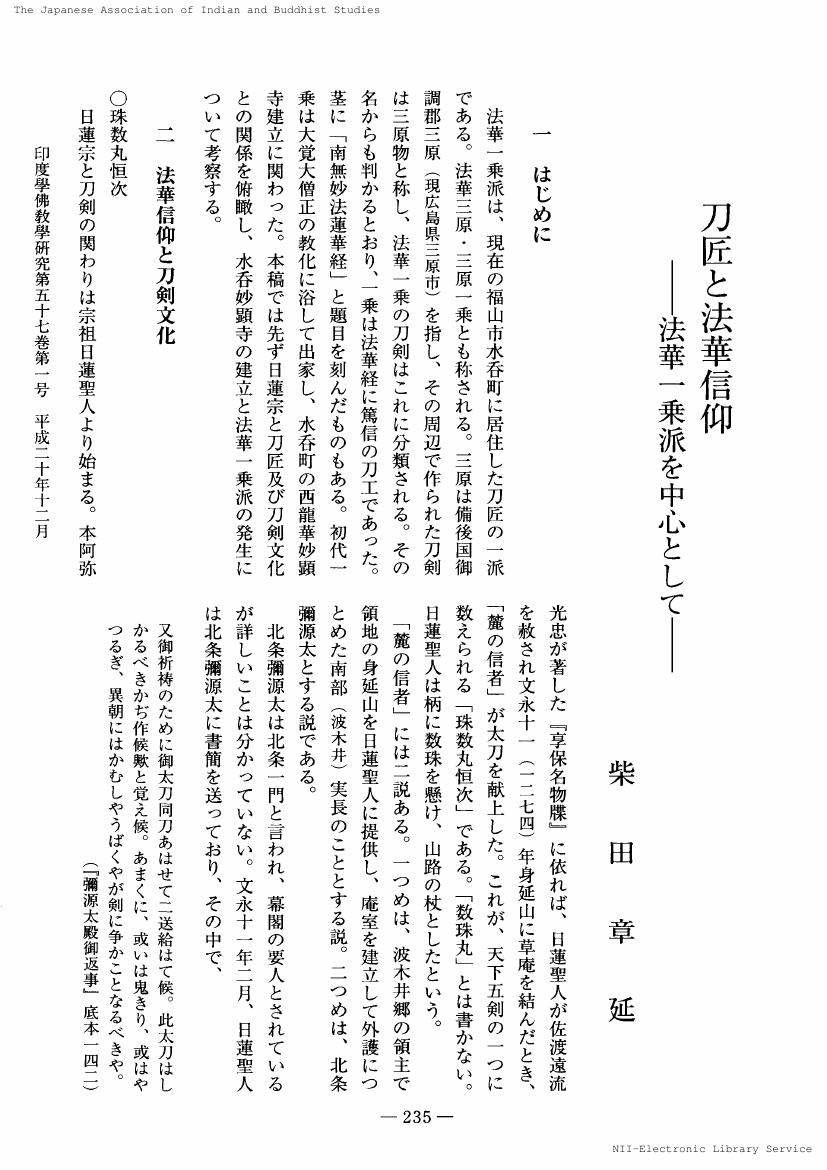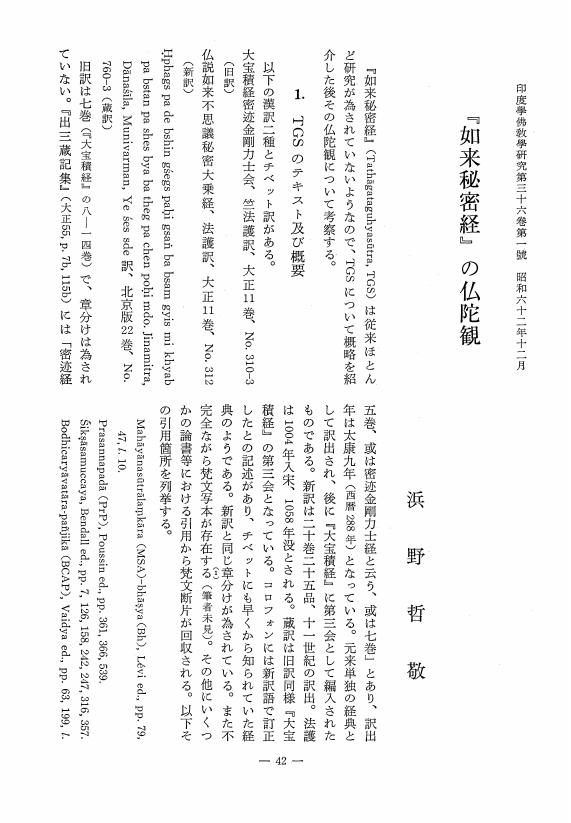2 0 0 0 OA 『マハーバーラタ』におけるダルマ神について――ユディシュティラに対する試練――
- 著者
- 伊藤 頼人
- 出版者
- 日本印度学仏教学会
- 雑誌
- 印度學佛教學研究 (ISSN:00194344)
- 巻号頁・発行日
- vol.68, no.2, pp.1096-1093, 2020-03-20 (Released:2020-09-10)
- 参考文献数
- 9
The term “dharma” is used in documents in ancient India to mean “justice,” “law,” or “virtue.” In contrast to dharma as an idea, in the Mahābhārata Dharma is a god with a body and mind, embodying the concept of “Dharma as god.” Dharma acts as the father of Yudhiṣṭhira, the oldest of the five sons of King Pāṇḍu (the Pāṇḍava) in the main story of the Mahābhārata. Dharma subjects Yudhiṣṭhira to three trials.This work focuses on trends evident in stories of the three trials of Yudhiṣṭhira. First, these stories have a common structure. Second, the stories relate the three trials in sequence. Third, ānṛśaṃsya (mercy) is described as the highest value. In stories of the three trials, ānṛśaṃsya is esteemed and described as specific behavior. Fourth, Yudhiṣṭhira chooses to act of his own will rather than following the recommendations of others. These trends are common to stories of the three trials.
2 0 0 0 OA 元代『科註妙法蓮華経』の刊行と流通
- 著者
- 朴 鎔辰
- 出版者
- 日本印度学仏教学会
- 雑誌
- 印度學佛教學研究 (ISSN:00194344)
- 巻号頁・発行日
- vol.64, no.2, pp.1013-1009, 2016-03-20 (Released:2017-09-01)
2 0 0 0 OA 八世紀における唯識学派の対外交流――崇俊・法清(法詳)を中心に――
- 著者
- 師 茂樹
- 出版者
- 日本印度学仏教学会
- 雑誌
- 印度學佛教學研究 (ISSN:00194344)
- 巻号頁・発行日
- vol.66, no.1, pp.1-9, 2017-12-20 (Released:2019-01-11)
- 参考文献数
- 19
- 被引用文献数
- 5
According to his stūpa inscription (Tang Chanzhisi gu dade fashi Chongjun ta ming bing xu唐禅智寺故大徳法師崇俊塔銘并序; Based on the glass dry plates of Tokyo National Research Institute for Cultural Properties), Chongjun (696–760) of the Chanzhisi temple in Yang province learned Yogācāra, Buddhist logic, the Lotus sūtra and Nirvāna sūtra from Zhizhou 智周,and traveled to Tufan 吐蕃 or Tibet. Faqing (or Faxiang), his immediate disciple, a Buddhist layman, responded to a Tōketsu 唐決 (Questions to the Chinese Buddhists) brought by Japanese monk Tokushō 徳清,according to Zōshun’s 蔵俊 Inmyō daisho shō 因明大疏抄 and Gen’ei’s 玄叡 Daijō sanron daigishō 大乗三論大義鈔.Although it is said that there was no doctrinal development of Chinese Yogācāra after Zhizhou, we can see the international interactions between the Chinese Yogācāra school and the surrounding areas in the 8th century.
2 0 0 0 神通より來迎へ -インド佛教文學に見られる天界訪問の二方法-
- 著者
- 前田 惠學
- 出版者
- 日本印度学仏教学会
- 雑誌
- 印度學佛教學研究 (ISSN:00194344)
- 巻号頁・発行日
- vol.7, no.1, pp.44-56, 1958
2 0 0 0 OA 刀匠と法華信仰 ――法華一乗派を中心として――
- 著者
- 柴田 章延
- 出版者
- 日本印度学仏教学会
- 雑誌
- 印度學佛教學研究 (ISSN:00194344)
- 巻号頁・発行日
- vol.57, no.1, pp.235-239, 2008-12-20 (Released:2017-09-01)
2 0 0 0 大乗義章三十講について
- 著者
- 田戸 大智
- 出版者
- 日本印度学仏教学会
- 雑誌
- 印度學佛教學研究 (ISSN:00194344)
- 巻号頁・発行日
- vol.61, no.1, pp.157-163, 2012
2 0 0 0 OA 明治印度留学生 ――その南アジア体験をめぐって――
- 著者
- 奥山 直司
- 出版者
- 日本印度学仏教学会
- 雑誌
- 印度學佛教學研究 (ISSN:00194344)
- 巻号頁・発行日
- vol.64, no.2, pp.1042-1035, 2016-03-20 (Released:2017-09-01)
- 被引用文献数
- 1
2 0 0 0 OA 『如来秘密経』の仏陀観
- 著者
- 浜野 哲敬
- 出版者
- Japanese Association of Indian and Buddhist Studies
- 雑誌
- 印度學佛教學研究 (ISSN:00194344)
- 巻号頁・発行日
- vol.36, no.1, pp.42-46, 1987-12-25 (Released:2010-03-09)
2 0 0 0 OA 下田正弘とグレゴリー・ショペン ――大乗仏教の起源をめぐって――
- 著者
- 佐々木 閑
- 出版者
- 日本印度学仏教学会
- 雑誌
- 印度學佛教學研究 (ISSN:00194344)
- 巻号頁・発行日
- vol.61, no.1, pp.342-334, 2012-12-20 (Released:2017-09-01)
2 0 0 0 OA 親鸞の妻恵信尼考 -親鸞の妻は宜秋門院であると思う-
- 著者
- 藤井 元了
- 出版者
- Japanese Association of Indian and Buddhist Studies
- 雑誌
- 印度學佛教學研究 (ISSN:00194344)
- 巻号頁・発行日
- vol.23, no.1, pp.178-179, 1974-12-25 (Released:2010-03-09)
2 0 0 0 永明延寿の思想・実践における浄土的要素
- 著者
- 柳 幹康
- 出版者
- 日本印度学仏教学会
- 雑誌
- 印度學佛教學研究 (ISSN:00194344)
- 巻号頁・発行日
- vol.69, no.1, pp.312-305, 2020-12
2 0 0 0 OA 『天神経』について
- 著者
- 服部 法照
- 出版者
- Japanese Association of Indian and Buddhist Studies
- 雑誌
- 印度學佛教學研究 (ISSN:00194344)
- 巻号頁・発行日
- vol.42, no.1, pp.184-187, 1993-12-25 (Released:2010-03-09)
2 0 0 0 OA 『梵網経』における「自誓受戒」について
- 著者
- 任 京美
- 出版者
- Japanese Association of Indian and Buddhist Studies
- 雑誌
- 印度學佛教學研究 (ISSN:00194344)
- 巻号頁・発行日
- vol.54, no.1, pp.512-509,1286, 2005-12-20 (Released:2010-07-01)
One characteristic of Mahayana bodhisattva precepts is the idea of “self-ordination”. In the case where one has no teacher, self ordination means vowing to keep the Buddhist precepts personally. Although in self ordination the spiritual aspect is stressed, there also need to be certain conditions for it to take place. This characteristic is explained in the idea of “visionary experience”, found in the 23rd precept of the Fanwang jing. This essay examines the influence of selfordination as found in the Fanwang jing, taking into account the Huayan jing and the point of view of practice.Visionary experience is built up through practice. In this way, the visionary experience is based on practice, and the person who completes “self ordination” follows the influence of the Huayan jing in the Fanwang jing, hence bodhisattva non-regression is necessary for visionary experience. The disciple of the Buddha is penitent, practices and sees the visionary experience as proof of ordination. Accordingly, the visionary experience found in “self ordination” of the Fanwang jing should be understood from the point of view of practice.
- 著者
- 佐久間 祐惟
- 出版者
- 日本印度学仏教学会
- 雑誌
- 印度學佛教學研究 (ISSN:00194344)
- 巻号頁・発行日
- vol.69, no.1, pp.108-111, 2020-12
2 0 0 0 平安時代の「結縁経」追考
- 著者
- 山口 希世美
- 出版者
- 日本印度学仏教学会
- 雑誌
- 印度學佛教學研究 (ISSN:00194344)
- 巻号頁・発行日
- vol.69, no.1, pp.51-54, 2020-12
2 0 0 0 平安時代後期における修善
- 著者
- 田中 夕子
- 出版者
- 日本印度学仏教学会
- 雑誌
- 印度學佛教學研究 (ISSN:00194344)
- 巻号頁・発行日
- vol.69, no.1, pp.55-59, 2020-12
2 0 0 0 OA 『花郎世紀』における諸問題
- 著者
- 福士 滋稔
- 出版者
- Japanese Association of Indian and Buddhist Studies
- 雑誌
- 印度學佛教學研究 (ISSN:00194344)
- 巻号頁・発行日
- vol.43, no.1, pp.262-266, 1994-12-20 (Released:2010-03-09)
2 0 0 0 智度論に引用された諸經典について
- 著者
- 三枝 充悳
- 出版者
- 日本印度学仏教学会
- 雑誌
- 印度學佛教學研究 (ISSN:00194344)
- 巻号頁・発行日
- vol.1, no.2, pp.390-391, 1953
2 0 0 0 日本唯識研究:『唯識分量決』と『四分義極略私記』
- 著者
- 太田 久紀
- 出版者
- 日本印度学仏教学会
- 雑誌
- 印度學佛教學研究 (ISSN:00194344)
- 巻号頁・発行日
- vol.21, no.1, pp.254-257, 1972
2 0 0 0 OA マーラの變容 : 死魔から他化自在天へ
- 著者
- 岩井 昌悟
- 出版者
- 日本印度学仏教学会
- 雑誌
- 印度學佛教學研究 (ISSN:00194344)
- 巻号頁・発行日
- vol.58, no.1, pp.364-359, 2009-12-20








